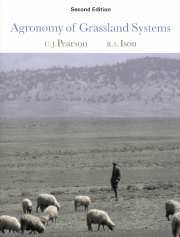Book contents
- Frontmatter
- Contents
- Preface
- 1 Overview: perspectives on grassland systems
- 2 The emergence of grassland systems
- 3 Generation
- 4 Vegetative growth
- 5 Flowering and seed production
- 6 Mineral nutrition
- 7 Herbage quality and animal intake
- 8 Grassland – animal interactions and management
- 9 Grassland systems design
- References
- Index
4 - Vegetative growth
Published online by Cambridge University Press: 05 June 2012
- Frontmatter
- Contents
- Preface
- 1 Overview: perspectives on grassland systems
- 2 The emergence of grassland systems
- 3 Generation
- 4 Vegetative growth
- 5 Flowering and seed production
- 6 Mineral nutrition
- 7 Herbage quality and animal intake
- 8 Grassland – animal interactions and management
- 9 Grassland systems design
- References
- Index
Summary
Growth is the change, usually an increase, in biomass. We talk of the growth of a leaf, a plant or a grassland. Grassland growth is equivalent to productivity and is measured as tonnes of herbage per ha per year. Growth proceeds at a rate that varies over time and for a duration that depends on the life cycle of the plants and on their environment and management.
Development, however, refers to the passage of an organism through its life cycle. This passage may be considered at the organelle or organ level or for the whole organism or grassland community (Fig. 1.4).
The life cycle of a herbage plant is divided into two developmental phases: vegetative and reproductive, according to whether meristems are seen to be producing further leaves or flowers respectively (Fig. 4.1). This superficial classification is widely used in grassland agronomy and it is often the basis of management, e.g. hay-making, at ‘the beginning of the reproductive phase’ (one-tenth bloom in lucerne). However, Fig. 4.1 shows that there are a number of developmental events within the life of a herbage plant. This chapter discusses the development of vegetative organs and their rate of growth; Chapter 5 deals with the development of flowers and seeds.
Grasslands may be classified into five broad groups according to the developmental patterns of the main species in them:
(i) Annuals, in which the major component of the grassland is generated from seed and resown each year.
(ii) […]
- Type
- Chapter
- Information
- Agronomy of Grassland Systems , pp. 60 - 82Publisher: Cambridge University PressPrint publication year: 1997

